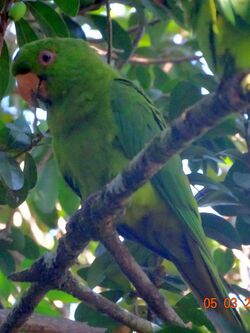Biology:Socorro parakeet
| Socorro parakeet | |
|---|---|

| |
| Scientific classification | |
| Domain: | Eukaryota |
| Kingdom: | Animalia |
| Phylum: | Chordata |
| Class: | Aves |
| Order: | Psittaciformes |
| Family: | Psittacidae |
| Genus: | Psittacara |
| Species: | P. brevipes
|
| Binomial name | |
| Psittacara brevipes (Lawrence, 1871)
| |
| Synonyms | |
The Socorro parakeet (Psittacara brevipes), known in aviculture as the Socorro green conure or Socorro conure[4], is a species of bird in subfamily Arinae of the family Psittacidae, the African and New World parrots. It is endemic to Socorro Island in the Revillagigedo Islands, Mexico.[5]
Taxonomy and systematics
The International Ornithological Committee and the Clements taxonomy treat the Socorro parakeet as a full, monotypic, species.[5][6] BirdLife International's Handbook of the Birds of the World (HBW) considers it to be a subspecies of the green parakeet (P. holochlorus).[3]
Description
The Socorro parakeet is 31 to 33 cm (12 to 13 in) long. The sexes are alike. It is essentially all green with a somewhat olive tinge to the underside of the flight feathers and tail. Its iris is orange-red surrounded by bare purplish brown skin, its bill horn colored, and its legs brownish.[2][7]
Distribution and habitat
The Socorro parakeet is found only on Socorro Island off the western coast of Mexico. It inhabits forests dominated by Bumelia socorrensis, Ilex socorrensis, and Guettarda insularis, and is usually found at elevations above 500 m (1,600 ft).[2]
Behavior
Movement
The Socorro parakeet is sedentary.[2]
Feeding
One study found that about half of the Socorro parakeet's diet was seeds and fruit pulp of Bumelia socorrensis with those of Ilex socorrensis, Guettarda insularis, and Psidium making up most of the rest.[2][8]
Breeding
The Socorro parakeet breeds between October and January. It typically nests in a cavity in a Bumelia socorrensis tree about 2.3 to 3.8 m (8 to 10 ft) above the ground.[2]
Vocalization
As of early 2023, xeno-canto had only three recordings of Socorro parakeet vocalizations; the Cornell Lab of Ornithology's Macaulay Library had many. Neither described the vocalizations in words.[2]
Status
The IUCN follows HBW taxonomy and so has not assessed the Socorro parakeet separately from the green parakeet. It does note that as a subspecies it is "regarded as highly threatened".[9] The species is threatened by habitat destruction by sheep and predation by feral cats. In 2006 and 2007 its population was estimated at about 300 individuals, a decrease from estimates in the early 1990s of 400 to 500.[9][2] It may meet the criteria for a Vulnerable or Endangered species.[10]
References
- ↑ "Appendices | CITES". https://cites.org/eng/app/appendices.php.
- ↑ 2.0 2.1 2.2 2.3 2.4 2.5 2.6 2.7 Collar, N., G. M. Kirwan, C. J. Sharpe, and P. F. D. Boesman (2020). Socorro Parakeet (Psittacara brevipes), version 1.0. In Birds of the World (S. M. Billerman, B. K. Keeney, P. G. Rodewald, and T. S. Schulenberg, Editors). Cornell Lab of Ornithology, Ithaca, NY, USA. https://doi.org/10.2173/bow.grnpar2.01 retrieved April 5, 2023
- ↑ 3.0 3.1 HBW and BirdLife International (2022) Handbook of the Birds of the World and BirdLife International digital checklist of the birds of the world. Version 7. Available at: http://datazone.birdlife.org/userfiles/file/Species/Taxonomy/HBW-BirdLife_Checklist_v7_Dec22.zip retrieved December 13, 2022
- ↑ "SOCORRO CONURE (Psittacara brevipes)". World Parrot Trust. https://www.parrots.org/encyclopedia/socorro-conure.
- ↑ 5.0 5.1 "Parrots, cockatoos". January 2023. https://www.worldbirdnames.org/new/bow/parrots/.
- ↑ Clements, J. F., T. S. Schulenberg, M. J. Iliff, T. A. Fredericks, J. A. Gerbracht, D. Lepage, S. M. Billerman, B. L. Sullivan, and C. L. Wood. 2022. The eBird/Clements checklist of birds of the world: v2022. Downloaded from https://www.birds.cornell.edu/clementschecklist/download/ retrieved November 10, 2022
- ↑ Eitniear, J. C., N. Collar, C. J. Sharpe, and P. F. D. Boesman (2020). Green Parakeet (Psittacara holochlorus), version 1.0. In Birds of the World (S. M. Billerman, B. K. Keeney, P. G. Rodewald, and T. S. Schulenberg, Editors). Cornell Lab of Ornithology, Ithaca, NY, USA. https://doi.org/10.2173/bow.grnpar.01 retrieved April 5, 2023
- ↑ Rodríguez-Estrella, R., Mata, E. and Rivera, L. (1992). Ecological notes on the Green Parakeet of Isla Socorro, Mexico. Condor. 94(2): 523-525
- ↑ 9.0 9.1 BirdLife International (2018). "Green Parakeet Aratinga holochlorus". IUCN Red List of Threatened Species 2018: e.T62296899A132190435. doi:10.2305/IUCN.UK.2018-2.RLTS.T62296899A132190435.en. https://www.iucnredlist.org/species/62296899/132190435. Retrieved 5 April 2023.
- ↑ Martínez-Gómez, J. E., Matías-Ferrer, N., & Escalante-Pliego, P. (2017). Phylogeny and taxonomy of the Socorro parakeet (Psittacara holochlorus brevipes): Recent speciation with minor morphological differentiation. Journal of Ornithology, 158(4), 965-978. doi:10.1007/s10336-017-1465-4
Wikidata ☰ Q2736310 entry
 |

